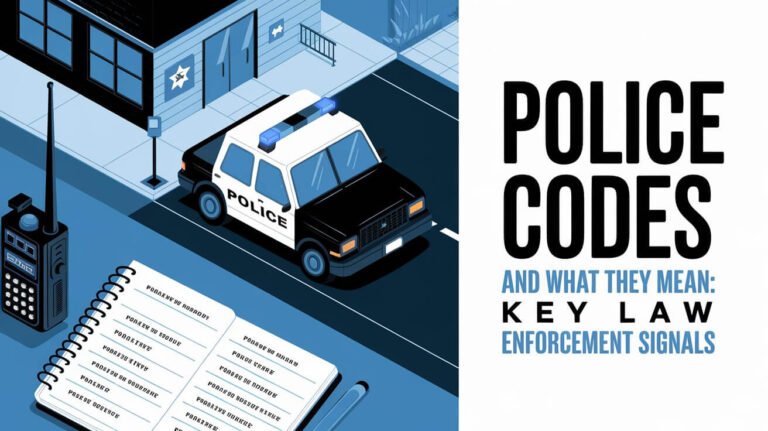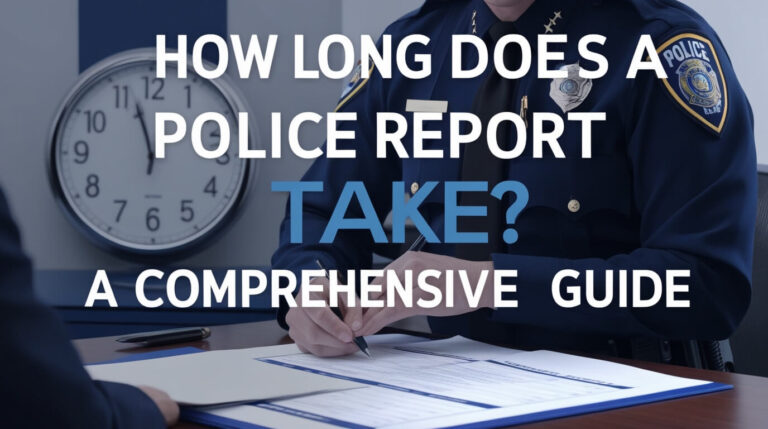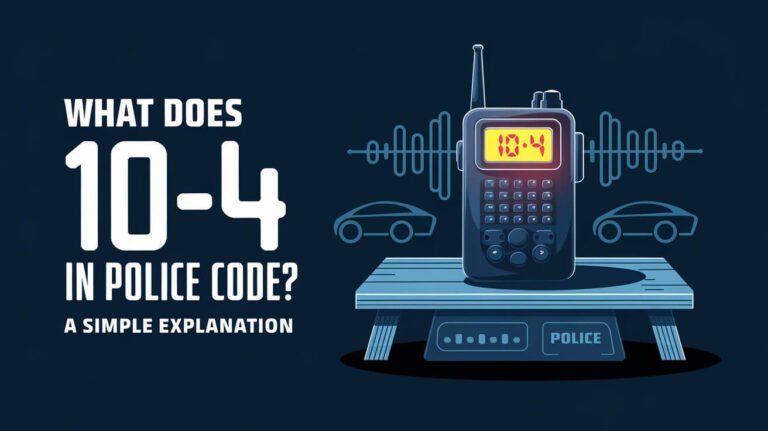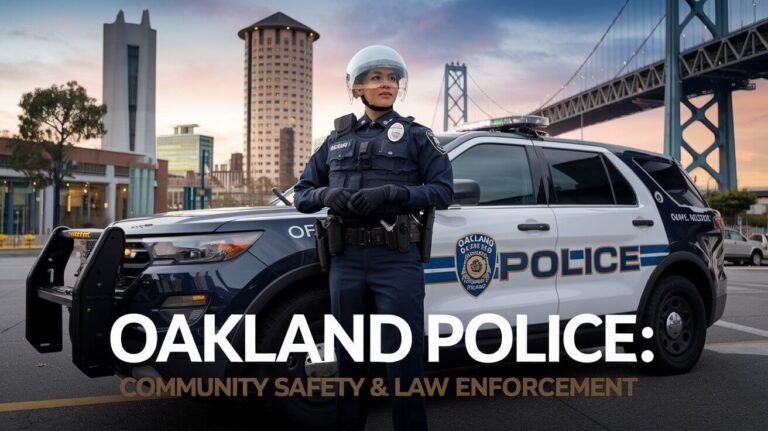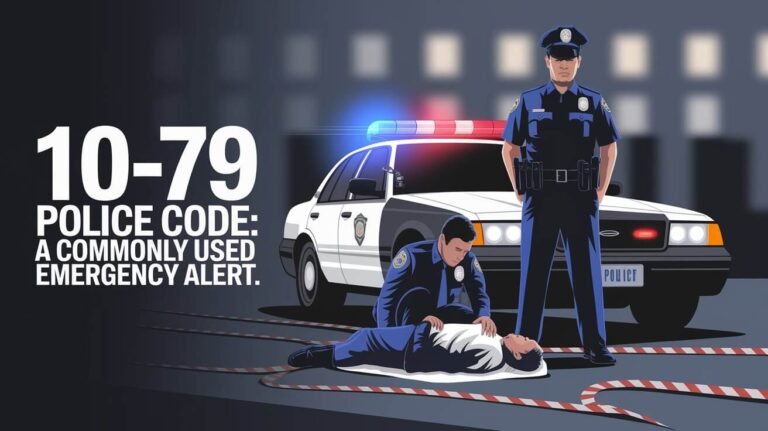10 52 Police Code and What It Indicates on Scene

In emergency situations, effective communication is crucial for law enforcement agencies to respond promptly and efficiently. One critical tool used in these situations is the 1052 police code, which is used to request an ambulance.
Law enforcement communication relies heavily on emergency codes like the 1052 police code to convey vital information quickly. These codes play a significant role in ensuring that the right response is dispatched to emergency situations.
By understanding police codes and their significance in emergency communication, individuals can better appreciate the complexity and coordination involved in law enforcement operations, including ambulance requests.
Key Takeaways
- Effective communication is critical in emergency situations.
- The 1052 police code is used to request an ambulance.
- Emergency codes are vital for law enforcement communication.
- Understanding police codes enhances appreciation for law enforcement operations.
- Police codes play a significant role in dispatching the right response to emergencies.
What Is the 10-52 Police Code?
Understanding the 10-52 police code is crucial for effective emergency communication. The 10-52 code is used to request an ambulance or indicate a medical emergency.
Definition and Basic Meaning
The 10-52 police code is specifically used to signal that a medical emergency exists, and an ambulance is required. This code is part of a larger system of police codes used for quick and efficient communication during emergency situations.
Key aspects of the 10-52 code include:
- Requesting an ambulance
- Indicating a medical emergency
- Facilitating quick response by emergency services
Regional Variations of the Code
While the 10-52 code generally signifies a medical emergency, there can be regional variations in its usage and interpretation. Different jurisdictions may use police codes slightly differently, which can impact emergency communication, especially during multi-agency responses.
Some factors influencing regional variations include:
- Local emergency response protocols
- Specific police code systems adopted by jurisdictions
- Training and familiarity of responders with the codes
History of Police Radio Codes
Understanding the evolution of police radio codes provides insight into law enforcement’s communication strategies. The development of these codes was crucial for efficient and clear communication, especially in emergency situations.
Origins of the Ten-Code System
The ten-code system, a cornerstone of police radio codes, originated in the early 1930s. Charles Hopper, the Illinois State Police Communications Director, is credited with developing the first ten-codes to simplify and standardize police communication. The system was designed to be concise, using numerical codes to represent common phrases, thus reducing transmission time and enhancing clarity.
The initial set of codes was not universally adopted until later, but they gradually became a standard across various law enforcement agencies. The ten-code system was particularly useful in the era of radio communication, where clarity and brevity were paramount.
Evolution Through the Decades
Over the decades, the ten-code system has evolved. Initially, there were variations in how different agencies used the codes, leading to potential confusion. Efforts to standardize the codes were made, but regional differences persisted. The Association of Public-Safety Communications Officials (APCO) played a significant role in promoting standardization.
In recent years, the shift towards plain language communication has led to a reevaluation of the ten-code system’s role. While some agencies continue to use ten-codes, others have moved towards more straightforward language to avoid confusion, especially in multi-agency responses.
How the 10-52 Code Is Used in Emergency Situations
The 10-52 police code is a critical component of emergency response protocols, facilitating swift medical interventions. In emergency situations, effective communication is paramount, and the 10-52 code plays a vital role in requesting medical assistance.
Dispatch Protocols
Dispatch protocols are essential in emergency situations, as they ensure that the right resources are allocated promptly. When a 10-52 code is received, dispatchers follow established procedures to dispatch an ambulance to the scene.
Key aspects of dispatch protocols include:
- Assessing the situation to determine the level of medical response required
- Dispatching an ambulance with the appropriate level of care
- Providing critical information to the responding medical team
First Responder Actions
First responders play a crucial role in emergency situations, and their actions are guided by the information received from dispatchers. When a 10-52 code is dispatched, first responders understand that a medical emergency is at hand.
Response Time Priorities
Response time priorities are critical in emergency situations. First responders must quickly assess the situation and provide the necessary medical assistance.
Coordination with Medical Services
Coordination with medical services is vital to ensure that patients receive the necessary care. First responders work closely with medical personnel to provide seamless care.
| Response Priority | Actions Taken | Coordination with Medical Services |
|---|---|---|
| High | Immediate response to the scene, assessment of the situation | Notification of medical services, provision of critical information |
| Medium | Response to the scene, provision of medical assistance | Coordination with medical services to determine the best course of action |
| Low | Response to the scene, assessment of the situation, and provision of basic care | Notification of medical services, coordination for further care |
10-52 Police Code Across Different Jurisdictions
The usage of the 10-52 police code varies significantly across different jurisdictions in the United States. This variation is attributed to the diverse needs and protocols of law enforcement agencies at the state and local levels.
State-by-State Variations
Different states have adopted the 10-52 code with varying interpretations and applications. For instance:
- California: Uses the 10-52 code primarily for reporting stolen vehicles.
- New York: Employs the code for a broader range of situations, including major crimes.
- Texas: Has a unique adaptation that includes additional context for certain emergencies.
These state-by-state variations highlight the need for law enforcement officers to be aware of the specific protocols in their jurisdiction.
Federal vs. Local Usage
The application of the 10-52 code also differs between federal and local law enforcement agencies. Federal agencies tend to use standardized codes across their operations, while local agencies may adapt codes to fit their specific needs.
Major City Departments
Major city police departments, such as the NYPD, have developed complex systems that incorporate the 10-52 code into their dispatch protocols. These departments often have specialized units that require nuanced communication.
Rural Area Adaptations
In contrast, rural areas may use simplified versions of the code due to limited resources and different types of emergencies. For example, a rural department might use the 10-52 code primarily for urgent situations like officer assistance.
Related Emergency Codes in the Ten-Code System
Beyond the 10-52 police code, the ten-code system includes various other emergency codes that play vital roles in different situations. These codes are designed to facilitate clear and efficient communication among emergency responders.
Medical Emergency Codes
Medical emergency codes are a critical component of the ten-code system, enabling responders to quickly identify and respond to medical emergencies. For instance, codes like 10-45 and 10-46 are used to signal the need for paramedics or to indicate that a patient is being transported.
Key Medical Emergency Codes:
- 10-45: Patient in danger
- 10-46: Motorist/patient assist
- 10-47: Emergency road condition
Priority and Urgency Indicators
Priority and urgency indicators are essential for conveying the severity of a situation. These codes help in allocating resources effectively and ensuring that the most critical emergencies receive immediate attention.
Code Combinations
Code combinations allow for more nuanced communication, enabling responders to convey complex information quickly. For example, combining a medical emergency code with a priority indicator can signal both the nature of the emergency and its level of urgency.
Examples of Code Combinations:
- Using 10-33 (Emergency Message) with 10-45 (Patient in danger) to signal a critical medical emergency.
- Combining 10-52 (Ambulance/paramedics needed) with 10-23 (Arrived on scene) to indicate that paramedics have arrived at the scene.
Supplemental Information Protocols
Supplemental information protocols provide additional context to emergency codes, enhancing situational awareness. These protocols can include details such as the number of patients, the severity of injuries, or specific hazards at the scene.
| Protocol | Description |
|---|---|
| Patient Count | Indicates the number of patients involved in an incident. |
| Hazard Notification | Alerts responders to potential hazards at the scene, such as hazardous materials. |
Shift from Ten-Codes to Plain Language
The emergency services sector is witnessing a significant shift from traditional ten-codes to plain language for clearer communication. This change is driven by the need for more effective and efficient communication during emergency responses. As emergency services continue to evolve, the importance of clear communication cannot be overstated.
NIMS and Standardization Efforts
The National Incident Management System (NIMS) plays a crucial role in promoting the use of plain language in emergency communication. NIMS aims to standardize response protocols across different agencies and jurisdictions, ensuring that emergency responders can work together seamlessly. Standardization efforts under NIMS have been instrumental in driving the adoption of plain language.
Standardizing communication protocols, NIMS helps reduce confusion and misinterpretation during emergency responses. This is particularly important in multi-agency responses where clear communication is critical. The use of plain language facilitates a more unified and coordinated response.
Benefits of Clear Communication
Clear communication offers several benefits in emergency response situations. It enhances cross-agency cooperation and simplifies training for emergency responders. Two key advantages of clear communication are:
- Cross-Agency Cooperation: Plain language facilitates better understanding among different agencies, improving overall response effectiveness.
- Training Simplification: By using plain language, training programs for emergency responders become more straightforward, as there’s less need to memorize complex codes.
Cross-Agency Cooperation
When different agencies use the same language during emergency responses, it fosters a more collaborative environment. This cooperation is essential for effective response and rescue operations. Plain language ensures that all parties involved understand each other clearly, reducing the risk of misunderstandings.
Training Simplification
The use of plain language simplifies the training process for new emergency responders. Without the need to learn complex ten-codes, trainees can focus on other critical aspects of their job. This streamlined training process contributes to a more efficient and effective emergency response system.
Police Code 10-52 in Popular Media
In popular culture, the 10-52 police code is often depicted in TV shows and movies, but its representation can be inconsistent. The use of police codes like 10-52 adds a layer of authenticity to these productions, but it also raises questions about accuracy and the potential for misinformation.
Representation in TV Shows and Movies
TV shows and movies frequently incorporate police codes, such as the 10-52 code, into their storylines. These codes are often used to create suspense, convey urgency, or simply to add realism to a scene. However, the accuracy of these depictions can vary widely depending on the production’s attention to detail and the creative liberties taken by the writers.
Some productions consult with law enforcement professionals to ensure accuracy, while others may use codes incorrectly or out of context. This can lead to a mixed understanding of what the 10-52 code actually signifies among viewers.
Accuracy vs. Dramatic License
The balance between accuracy and dramatic license is a delicate one in the representation of police codes in media. While accuracy is important for authenticity, dramatic license is often necessary to advance the plot or create tension.
Key considerations include:
- Ensuring that the use of police codes like 10-52 is consistent with their real-world meaning
- Avoiding the misuse of codes for dramatic effect in a way that could mislead viewers
- Consulting with law enforcement experts to validate the representation of police procedures
Common Misconceptions
One common misconception is that police codes are used universally across different jurisdictions. In reality, the meaning of codes like 10-52 can vary by region, leading to potential confusion.
Notable Examples in Film
Some films and TV shows have been praised for their accurate depiction of police codes, while others have been criticized for inaccuracies. Notable examples include shows that have consulted with law enforcement and those that have taken creative liberties with police procedures.
Scanner Technology and Monitoring Police Codes
Scanner technology plays a crucial role in monitoring police communications, including the 10-52 code. This technology allows individuals to stay informed about police activities in their area.
Legal Aspects of Scanner Use
The use of scanner technology to monitor police codes is subject to various legal considerations. In the United States, the legality of using scanners varies by state, with some states imposing restrictions on the use of such technology.
Key legal aspects to consider include:
- Licensing requirements for scanner use
- Restrictions on the type of information that can be monitored
- Penalties for misuse of scanner technology
Digital Encryption Challenges
As technology advances, many police departments are switching to digital encryption for their communications. This shift poses a challenge for scanner users, as encrypted signals can no longer be monitored with traditional scanners.
| Aspect | Traditional Scanning | Digital Encryption |
|---|---|---|
| Accessibility | Easy to monitor | Limited access due to encryption |
| Security | Vulnerable to interception | More secure due to encryption |
| User Impact | Wide range of users | Limited to authorized personnel |
Smartphone Apps for Code Monitoring
The rise of smartphone apps has made it easier for individuals to monitor police codes. These apps often provide real-time updates and can be more convenient than traditional scanners.
Privacy Concerns and Regulations
The use of scanner technology and smartphone apps for monitoring police codes raises privacy concerns. Regulations are being put in place to balance the need for public information with individual privacy rights.
Key considerations include:
- Ensuring that the use of scanner technology complies with privacy laws
- Regulating the dissemination of information obtained through scanner use
Conclusion
The 10-52 police code plays a vital role in emergency communication, serving as a critical tool for law enforcement agencies to convey specific information quickly and efficiently. Throughout this article, we have explored the definition, history, and usage of the 10-52 code, as well as its place within the broader ten-code system used by law enforcement.
Effective emergency communication is crucial for successful law enforcement operations. Police codes like 10-52 facilitate clear and concise communication among responders, enabling them to respond appropriately to various situations. Understanding these codes is essential for both law enforcement personnel and the general public, as it fosters a deeper appreciation for the complexity of emergency response.
As law enforcement continues to evolve, so too does the technology and protocols surrounding emergency communication. The shift towards plain language and standardized systems, such as those advocated by the National Incident Management System (NIMS), aims to improve interoperability and response times. By grasping the significance of police codes and their role in emergency communication, we can better support the critical work of law enforcement agencies.
Answered Questions
What does the 10-52 police code mean?
The 10-52 police code is used to request an ambulance in emergency situations, indicating a need for medical assistance.
Are police codes used universally across the United States?
No, police codes, including the 10-52 code, can vary across different jurisdictions, with state-by-state variations and differences between federal and local usage.
What is the history behind police radio codes?
Police radio codes originated from the need for concise communication during emergency situations, evolving over the decades to become an integral part of law enforcement communication.
How is the 10-52 code used in emergency situations?
The 10-52 code is used by law enforcement to request an ambulance, triggering dispatch protocols and first responder actions to provide medical assistance.
What is the role of NIMS in emergency communication?
NIMS, or the National Incident Management System, plays a crucial role in standardizing emergency communication, promoting the use of plain language to enhance cross-agency cooperation.
How are police codes represented in popular media?
Police codes, including the 10-52 code, are often depicted in TV shows and movies, sometimes accurately and other times with dramatic license, which can lead to misconceptions about their usage.
Can I monitor police codes using scanner technology?
Yes, scanner technology allows individuals to monitor police codes, but there are legal aspects to consider, such as regulations around scanner use and digital encryption challenges.
Why is understanding police codes important?
Understanding police codes, particularly the 10-52 code, is crucial in emergency situations, as it facilitates effective communication between law enforcement and medical services, ultimately saving lives.
What are some related emergency codes in the ten-code system?
Related emergency codes include medical emergency codes and priority indicators, which are used in conjunction with the 10-52 code to convey critical information during emergency situations.
Are there any benefits to using plain language in emergency communication?
Yes, using plain language in emergency communication enhances clarity, simplifies training, and promotes cross-agency cooperation, ultimately leading to more effective emergency response.

